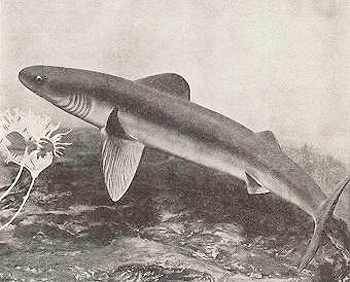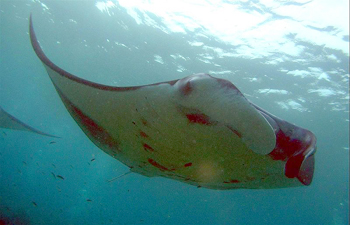What of the first claim, that sharks are Very, Very Old? This one is repeated so often as to be clichéd and conceals an interesting and quite different reality. All living sharks (and rays, to which we'll return in a moment) are descended from a common ancestor dating to the Triassic Period, probably somewhere between 240 - 220 million years ago. This makes the set of all living sharks and rays about the same age as dinosaurs and, surprisingly, just a hair older than mammals! So how do they get away with the perception that they're almost twice as old as that: the paleontological equivalent of an eleven-year old bellying up to the bar and scoring a beer?
It turns out that living sharks and rays are the only survivors of a much older and previously much larger set of fishes. Collectively known as chondrichthyans, or fishes-with-cartilage-skeletons, this crew is at least 400 million years old and was both amazingly diverse and often bizarre in appearance. Calling a more recently derived subset (living sharks and rays) of this ancient group 400 million years old is like calling me 200 years old because that's how far back I can trace my lineage. It doesn't work.

Cladoselache, an early chondrichthyan. From Wikimedia Commons.
So when people speak of sharks as being twice as old as dinosaurs, they're hopefully not referring to the age of the living group (although I fear this is often the case), but rather to the broader idea of "the shark." This is a different concept, that of the body plan or general architecture of the beast. Torpedo-shaped, toothy, with the typically sharky complement of fins slicing through the water. In doing so, they are placing "the shark" in the same bin as "the shrimp": an artificial group of organisms that pretty much look the same. Critically, this ignores 400 million years of weird experiments in the shark body plan. Just a few examples of extinct chondrichthyans include forms that resemble lumpy rocks, or eels with a long spine behind their head, or strange little undersea birds, or one with a spiral of teeth that no one quite knows where to place on the fish. For some beautiful reconstructions of these oddities, check out this article in Dive Magazine.
And let's not forget about those living exceptions that happen to comprise the group I study: the rays. Rays, skates and their relatives (collectively called batoids) are the majority of living shark and ray species, and precious few of them look anything like sharks. One colleague has gone so far as to call her skates "charismatic slimy pancakes of wonder." The group also includes what is considered to be the most derived, non-sharklike chondrichthyan of all, the manta ray.

Manta ray. Photo credit Richard Harvey, from Wikimedia Commons.
With this background, we can finally address the second claim. Has the shark body plan remained "essentially unchanged" over deep time? [Some creationist websites claim zero change, which is ludicrious to anyone with eyes and Google - try it yourself.] The answer to this question is more complex than that of the first.
At first blush, it seems simple. Having defined "the shark" as a body plan rather than as a natural set of organisms, the comparison between ancient and modern sharks is revealed to be circular. We've designated starting and ending points based on their similarity and then raise our eyebrows when they turn out to be similar. Wow. Consider an analogy from finance. If a trader tracks a thousand stocks over the course of a year, most will finish either up or down from their starting price. A few will finish at, or close enough to, their initial value. Is it then meaningful for the trader to ignore all but those few static stocks, and in his bias marvel at how little they've changed over time?
But fortunately the natural world isn't the DJIA, and perhaps there is some kernel of wisdom that we can salvage from this debacle. Just how similar are the body plans of shark-like chondrichthyans today and those of 400 million years ago? There have been important modifications to jaw suspension, the internal girdles supporting the paired fins, and so on, but much beyond that we're going out of bounds of our artificial body plan playing field. Sharks' hydrodynamic, torpedo-shaped architecture is what some biologists cheekily call A Good Trick: a trait that a group retains or multiple groups independently stumble upon because it's highly adaptive for their environment and way of life.
In one last attempt to address the question, let's turn for perspective to sharks' sister group, the osteichthyans or fishes-with-bony-skeletons. There are two subsets of these: the ray-finned fishes, which are nearly all "typical" fishes (see last week's post); and the lobe-finned fishes, which include coelacanths, lungfishes, and limbed vertebrates like... you! Both ray- and lobe-finned fishes date to a common ancestor that lived about 420 million years ago, which had that torpedo-shaped, vaguely shark-like body plan (the Good Trick). Since they've been evolving for as long as have sharks, what have they done with that body plan since?
Like their chondrichthyan cousins, the ray-finned fishes have diversified into many different amazing forms, from millstone-like sunfish to gulper eels to sleek barracuda. And also like chondrichthyans, the basic shark-like body plan persists as a common "starting material" for most of these daring experiments in anatomy. Some ray-finned fishes alive today resemble the earliest members of this group, at least to the extent that some modern sharks resemble their ancestors.
And the lobe-finned fishes? Living coelacanths and lungfishes number only enough species to count on both hands, but like living sharks and rays they represent formerly much larger groups that also explored weird body plan variations. Still being aquatic, they've retained the same basic architecture of their ancestors. But what about the third member of this group, the tetrapods ("four-footed" beasts)? Some surviving members have changed relatively little over time despite their own extinct and experimental offshoots, and again these are typically aquatic or amphibious forms like salamanders. Where we see dramatic deviations from the ancestral body plan are in groups that have escaped the water and stumbled upon a new Good Trick. Among many examples are: flight, which evolved three separate times in tetrapods; new, faster ways of running in mammals and dinosaurs; and treetop leaping and swinging in many primates. Others came full circle and returned to the water, re-evolving shark-like body plans from very different starting material. The best example of these are not whales but rather the ichthyosaurs ("fish-lizards").

Ophthalmosaurus, a Jurassic ichthyosaur. Ichthyosaurs re-derived a shark-like body plan from a lizard-like ancestor. Image credit Nobu Tamura, from Wikimedia Commons.
Perhaps, someday in the far future, humble mice will be the only surviving members of what was once the most body-plan-diverse group of vertebrates, the mammals. Will some alien television narrator compare these mice to their tiny ancestors that once crept around Jurassic jungles? Might she remark, "My! How little they have changed...?"
-NA


Hi Neil,
ReplyDeleteCool blog!! A similar situation occurs with crocodiles, with people saying "they're living fossils", "have remained unchanged for millions of years", etc. In the past this led people to place extinct forms in the genus Crocodylus, even including forms that are nested outside Crocodylidae as they are more basal! Are there similar problems with elasmos?
An alternative reconstruction of Helicoprion by some of the people at the USNM can be seen
here.
Hi, Jorge! Thanks for reading and for your thoughtful comment. One of my good friends works on crocodylomorphs and has told me about that problem. Many ray fossils are also stuck in artificial "garbage bin" genera. It's very frustrating.
ReplyDeleteI did see that interesting USNM reconstruction, but of course some people aren't happy with it. Haha.
Your blog continues to impress. Big time. Keep it up!